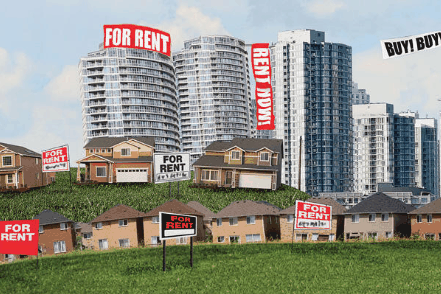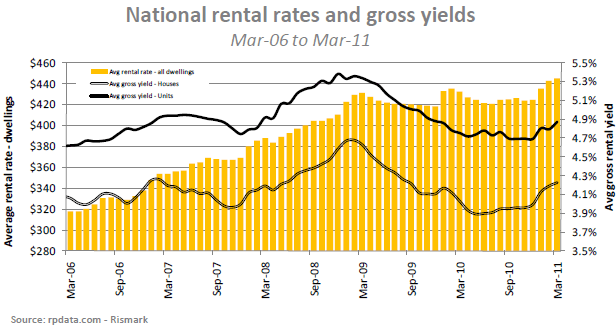
Economic forecasting – whether in relation to housing, currency, interest rates, or other markets – is tough. The world of economics and finance is very complex and predictions within a reasonable degree of confidence and accuracy 12 months hence are hard. Yet, the media continually publishes predictions by the nation’s economists and data analysts as if they are a foregone conclusion.
And so it goes with forecasts of rental growth. Over the past few years, I watched bewildered as the nation’s housing data providers offered bullish forecast after bullish forecast of sharply rising rents.
Australian Property Monitors (APM) have been especially bullish. In February 2010, they forecast that rents would rise by up to 11% nationally:
Research company Australian Property Monitors has forecast rent increases of up to 11 per cent in 2010 after little or no growth during most of 2009…
“An improving employment outlook means, overall, renters will be more willing and able to afford rental increases,” APM economist Matthew Bell says.
Ongoing housing shortages are expected to worsen as first-home owners opt out of buying and remain as renters.
Immigration continues to increase and more people are turning to bricks and mortar as an investment after being stung by the share market.
“On the supply side of things, there simply aren’t enough new properties being built for investment purposes to meet this increased demand,” Mr Bell says.
However, he says many rent rises will also be needed to recoup extra costs such as higher interest rates and land tax, not just additional profits for landlords.
APM ended up being way-off mark in their forecasts, with rental growth remaining subdued in 2010 according to RP Data. Still, this hiccup did not stop APM from predicting strong rental growth for 2011, again driven by strong economic activity and housing shortages:
“Renters should prepare for significant growth in rental prices throughout 2011, driven by accelerating economic activity, housing shortages and a depressed first homebuyer market,” said Dr Andrew Wilson, Senior Economist, Australian Property Monitors.
“Units in particular have seen a major shift in demand, with chronically low vacancy rates for inner-city residences in most capitals intensifying competition amongst prospective tenants for available properties.
“However it is expected that rising rental yields will renew investor interest in the market and may provide some relief for renters in the longer-term.”
For their part, RP Data have been more modest in their predictions for rental growth, albeit still too bullish.
In January 2009, RP Data made the following prediction about rental growth:
While many experts are predicting property values to remain relatively flat, rental yields are expected to strengthen further during the current housing shortage…
Cameron Kusher, senior research analyst with RP Data, noted that on a rolling six-month average basis, construction of new investment houses dropped by 7.9% in November 2008 compared to the month earlier. Over the year to November, the value of investment housing sank 17.9%, with volumes currently sitting at levels equivalent to those seen in mid-2007.
“The implication of fewer dwellings being built for investment and fewer existing properties being purchased is that the shortage of rental properties is likely to continue,” he said…
“With underlying demand increasing due to rising population growth, the housing shortage and the rental shortage situation is likely to become exacerbated,” he said.
“On the flipside, for those who own or are thinking of purchasing investment properties, it’s anticipated that rents will continue to rise as property values remain flat.
Then in 2010, RP data followed-up with this forecast of solid rental growth:
Rising house prices have pushed down the return for investors, with the gross rental yield for houses nationally falling from 4.7 per cent in January last year to 4.2 per cent this year.
The rental yield for apartments dropped from 5.3 per cent to 4.9 per cent.
“With rental demand likely to be higher during 2010 due to continuing strong migration and fewer first-home buyers, we anticipate that rents, and consequently yields, will improve over the year,” Mr Lawless said.
And in January this year, RP Data predicted that rents would rise 7% nationally:
“We expect rents to increase by around 7 per cent during 2011,” RP Data analyst Cameron Kusher said, adding rents would rise most for inner-city units and the more expensive housing markets on metropolitan outskirts.
“For the coming year we expect rental markets to tighten further and rental growth during 2011 will [most] likely eclipse that of 2010,” Mr Kusher said.
Now RP Data has released analysis showing that capital city rents have stalled, rising at only 2.7% in the year to June 2011 (i.e. below the rate of inflation):
Capital city weekly rental rates stalled in the June quarter, posting no growth in the latest sign of a cooling property market.
Median capital city rents were flat in the June quarter with only two capital cities showing increases in the quarter, in the latest sign of slowing activity in the real estate market.
In the year to June, capital city median rents – for houses and units – rose 2.7 per cent to $380 per week, according to RP Data…
To add insult to injury, rents have barely increased since the end of 2008 (most likely falling in real terms):
“As many investors will be aware, rental growth has been relatively subdued since 2008 due to a number of factors such as stimulus from low interest rates and the First Home Owner’s Grant Boost which enticed prospective new home owners into buying and eased demand for rentals,” said RP Data research director Cameron Kusher.
Certainly, RP Data’s own chart highlights the flattening of rental growth since late 2008 after a solid run-up in prior years:

Still, this hasn’t stopped RP Data from forecasting strong rental growth into the future:
Mr Kusher said he expected the pause in rental yield growth to be temporary.
“Limited new development during 2011 is likely to add to the upwards pressure on capital city rental rates and as a result we expect rental growth to revert to around five year average levels with inner city units and outer more affordable housing stock having the strongest prospects for rental growth,” said Mr Kusher.
I can only presume that Mr Kusher is not refering to Melbourne, which currently has the highest rental vacancy rates (and lowest yields) in the country, and thousands of new homes due to be completed over the next few years.
Some months ago, when The Australian secured Treasury discussions about the Australian housing bubble via freedom of information, economists there also expressed the hope that strongly rising rents would close the property valuation gap.
Right now, it appears a forlorn hope.

